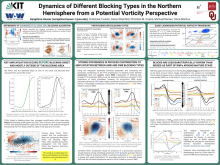Dynamics of different blocking types in the Northern Hemisphere from a potential vorticity perspective
Seraphine
Hauser
Karlsruhe Institute of Technology (KIT), Institute of Meteorology and Climate Research (IMK-TRO), Department Troposphere Research, Karlsruhe, Germany
Poster
Blocking anticyclones are persistent weather systems that strongly impact daily weather and are often linked to extreme weather events. However, state-of-the-art numerical weather prediction and climate models struggle with the correct representation of blocking. Although different physical mechanisms for blocking onset have been proposed, varying according to the type of block and the regional context, a complete understanding of how blocking forms is missing.
We use a quantitative potential vorticity (PV) tendency framework to quantify key processes for blocking onset: group propagation of Rossby waves, baroclinic interaction, the impact of upper-tropospheric divergent flow, and direct diabatic PV modification by non-conservative processes. We refined a well-known PV anomaly-based blocking index that captures a more realistic blocking frequency in summer and use this index to identify blocks in the Northern Hemisphere in ERA5 reanalysis. EOF analysis with k-means clustering is used to classify blocks into four different blocking types, namely cyclonic and anticyclonic Rossby wave breaking (CWB/AWB), omega and dipole blocks.
Tracing back the anticyclonic anomalies linked to blocking, we find that these anomalies typically originate remotely with the strongest amplification occurring in the three days before blocking onset. Thereby, anomalies are predominantly amplified due to upper-level divergent outflow, often linked to moist processes. Interestingly, the dynamics of blocking exhibit differences compared to the moist-baroclinic downstream development of ridges within Rossby wave packets. We furthermore identify differences in the dynamics between blocking types with the largest differences found between CWB and AWB. We conclude with a discussion about the internal variability within different blocking types.
We use a quantitative potential vorticity (PV) tendency framework to quantify key processes for blocking onset: group propagation of Rossby waves, baroclinic interaction, the impact of upper-tropospheric divergent flow, and direct diabatic PV modification by non-conservative processes. We refined a well-known PV anomaly-based blocking index that captures a more realistic blocking frequency in summer and use this index to identify blocks in the Northern Hemisphere in ERA5 reanalysis. EOF analysis with k-means clustering is used to classify blocks into four different blocking types, namely cyclonic and anticyclonic Rossby wave breaking (CWB/AWB), omega and dipole blocks.
Tracing back the anticyclonic anomalies linked to blocking, we find that these anomalies typically originate remotely with the strongest amplification occurring in the three days before blocking onset. Thereby, anomalies are predominantly amplified due to upper-level divergent outflow, often linked to moist processes. Interestingly, the dynamics of blocking exhibit differences compared to the moist-baroclinic downstream development of ridges within Rossby wave packets. We furthermore identify differences in the dynamics between blocking types with the largest differences found between CWB and AWB. We conclude with a discussion about the internal variability within different blocking types.

Poster file
Hauser-Seraphine-blocking-poster.pdf
(2.33 MB)
Meeting homepage
